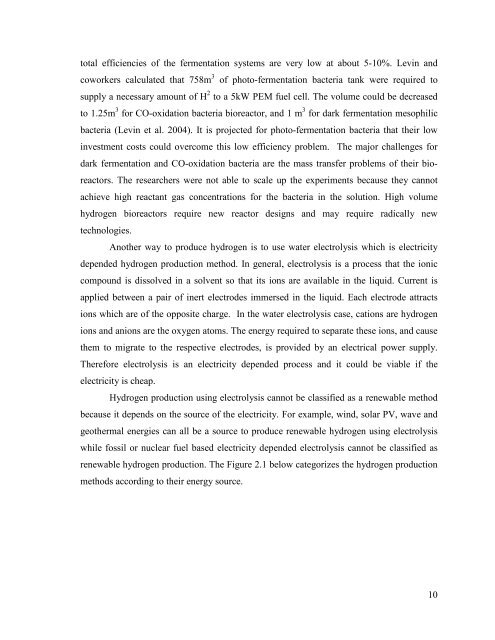hydrogen production from water using solar cells powered nafion ...
hydrogen production from water using solar cells powered nafion ...
hydrogen production from water using solar cells powered nafion ...
You also want an ePaper? Increase the reach of your titles
YUMPU automatically turns print PDFs into web optimized ePapers that Google loves.
total efficiencies of the fermentation systems are very low at about 5-10%. Levin and<br />
coworkers calculated that 758m 3 of photo-fermentation bacteria tank were required to<br />
supply a necessary amount of H 2 to a 5kW PEM fuel cell. The volume could be decreased<br />
to 1.25m 3 for CO-oxidation bacteria bioreactor, and 1 m 3 for dark fermentation mesophilic<br />
bacteria (Levin et al. 2004). It is projected for photo-fermentation bacteria that their low<br />
investment costs could overcome this low efficiency problem. The major challenges for<br />
dark fermentation and CO-oxidation bacteria are the mass transfer problems of their bio-<br />
reactors. The researchers were not able to scale up the experiments because they cannot<br />
achieve high reactant gas concentrations for the bacteria in the solution. High volume<br />
<strong>hydrogen</strong> bioreactors require new reactor designs and may require radically new<br />
technologies.<br />
Another way to produce <strong>hydrogen</strong> is to use <strong>water</strong> electrolysis which is electricity<br />
depended <strong>hydrogen</strong> <strong>production</strong> method. In general, electrolysis is a process that the ionic<br />
compound is dissolved in a solvent so that its ions are available in the liquid. Current is<br />
applied between a pair of inert electrodes immersed in the liquid. Each electrode attracts<br />
ions which are of the opposite charge. In the <strong>water</strong> electrolysis case, cations are <strong>hydrogen</strong><br />
ions and anions are the oxygen atoms. The energy required to separate these ions, and cause<br />
them to migrate to the respective electrodes, is provided by an electrical power supply.<br />
Therefore electrolysis is an electricity depended process and it could be viable if the<br />
electricity is cheap.<br />
Hydrogen <strong>production</strong> <strong>using</strong> electrolysis cannot be classified as a renewable method<br />
because it depends on the source of the electricity. For example, wind, <strong>solar</strong> PV, wave and<br />
geothermal energies can all be a source to produce renewable <strong>hydrogen</strong> <strong>using</strong> electrolysis<br />
while fossil or nuclear fuel based electricity depended electrolysis cannot be classified as<br />
renewable <strong>hydrogen</strong> <strong>production</strong>. The Figure 2.1 below categorizes the <strong>hydrogen</strong> <strong>production</strong><br />
methods according to their energy source.<br />
10

















